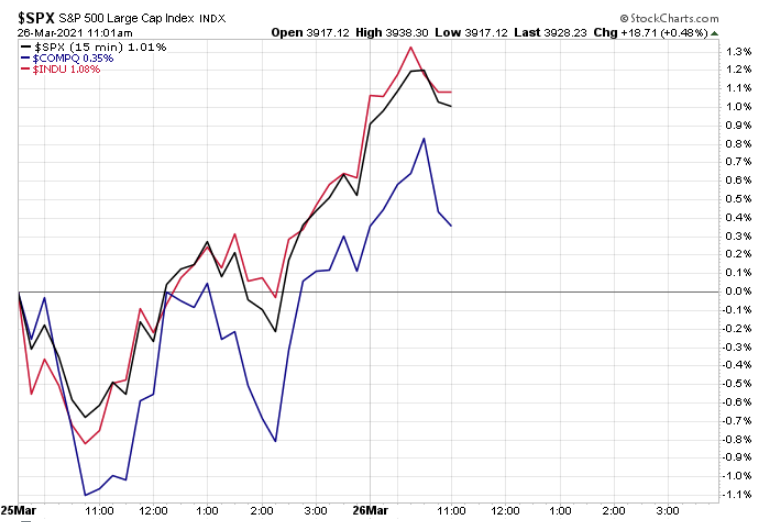Had enough of the market whiplash yet?
Yesterday, the S&P 500 closed 0.5% higher at 3,909.52. This came after a nerve-racking start to trading, which saw the index lose nearly 1% intraday. The Dow Jones Industrial Average gained 199.42 points, or 0.6%, rising to 32,619.48 — this again only after losing 348 points in early trading. The Nasdaq Composite trailed the two other major indexes, barely gaining 0.1% to close at 12,977.68.

The violent ups and downs of a sideways market can give any investor — even those with years of experience — anxiety.
When your hard-earned cash is disappearing right before your very eyes, how could it not?
The important thing to remember is now’s not the time to panic and run for the hills.
Sure, Thursday’s action was nerve-racking. Panic sellers took control early. In the business, we call those sellers the “scared hands.” Thankfully, some of those scared hands were shaken out of the market yesterday.
That’s a good thing for us. The fewer nervous Nellies we have trading with emotion, FOMO, and irrational exuberance, the better in my opinion.
However, the truth is no matter how many jittery investors exit the market, this sideways chop is going to be the norm for a while — most likely for the entire year. The reasons behind the chop will vary week to week. But the strategies we will employ to stay ahead and profitable will usually stay the same.
I want to make profiting in these conditions as straightforward as possible. You have enough to worry about already, after all.
This week’s soft market action was driven by a mix of ongoing trends — namely rotation into value and inflation concerns — along with other unique global events. First, pressure on global shipping due to a colossal ship running aground in the narrow Suez Canal added downward pressure on oil and other commodities earlier this week.
Then, none other than nefarious madman and ruthless pudge-pie Kim Jong-Un and his central government in North Korea decided to rattle the saber and conduct two ballistic missile tests in a brazen violation of current sanctions levied on the rogue nation.

Source: CBS News
As a result last night, Asian markets were trending downward early before eking out modest gains on the day.
Sidenote: If you’re like me and enjoy listening to market reports before bedtime, the direction Asia’s major indexes take can often indicate which way U.S. indexes will trade the next day.
The good news is if you’ve followed any of my advice over the past months, you’re well-positioned to stay ahead of these trends and remain profitable.
Our analysts have traveled the world over, dedicated to finding the best and most profitable investments in the global energy markets. All you have to do to join our Energy and Capital investment community is sign up for the daily newsletter below.The Best Free Investment You’ll Ever Make
Steady Gains All Around
Here’s where our stocks stand today if you happened to act on my suggestions.
On December 4, we got ahead of the expected rise in oil prices, and I suggested taking a swing on Baker Hughes (NYSE: BKR), Chevron Corp. (NYSE: CVX), and Valero Energy (NYSE: VLO). Since then, those stocks are up 6%, 16%, and 20%, respectively.
In anticipation of the global economy reopening and the unique logistics required for the COVID-19 vaccine rollout, we took a small position in Carrier Global (NYSE: CARR) on December 9, 2020. As of today’s open, CARR shares are up almost 9%.
Melding two powerful market trends together — a rotation into value stocks coupled with the ever-present need for innovative tech solutions — I suggested a stake in Dell Technologies Inc. (NYSE: DELL) back on January 1. Unlike many of its comparative tech plays, DELL is up over 18% since then.
Most recently, we combined the reopening trend and rotation into value plays with multiple stakes in casinos. On February 5, we opened positions in Caesars Entertainment Inc. (NASDAQ: CZR), Wynn Resorts Ltd. (NASDAQ: WYNN), and MGM Resorts International (NYSE: MGM). Over the past two months, those positions are up 6%, 9.5%, and 10%, respectively.
Is it time to just take our gains and wait out the chop? You can, but I have a better idea.
Dollar-Cost Averaging Is Your Best Option to Mitigate Downside Risk
Dollar-cost averaging is an investment strategy in which you divide the total amount of money you plan to invest in an asset into periodic purchases rather than in one lump sum. The strategy is employed to reduce the impact of general market volatility on your positions. Another benefit of this strategy is that it eliminates the time you need to spend defining quality entry and exit points.
You can use this strategy whether you anticipate the stock will rise or fall in value over a given period of time. For our purposes, we would employ this strategy on the aforementioned stocks to manage the downside risk in our positions.
Because we are up currently in our positions, in anticipation of more volatility, we can set specific buy prices for our assets at specific intervals that are lower than our original buy-in price. I like to set my first interval buy at 2%–5% below my original buy-in price and then spread out the remaining purchase at 2%–5% intervals from there. If shares of any of our assets fall to our predefined levels, we will add to our position rather than try to cut our losses.
On the surface, this may seem counterintuitive. Why buy a stock on the way down?
Well…
When we moved into these stocks, they had the benefit of momentum given various trends, they were fundamentally sound companies, and each had attractive entry points from a technical standpoint.
But sometimes greater unperceivable events throw a wrench into our plans. But if we essentially buy on the dip — at well-defined and well-researched price points — when the fundamentals and technicals realign, your average will increase significantly.
Let’s use our best performer Dell as an example.
My year-end price point for the stock is $100. But I do not expect this run to $100 per share to be in a straight line up. A 10% correction is a real possibility along the way.
Now, let’s say we decide on a plan to place a few interval purchases at dips of 2%, 6%, and 10% below our original buy price of $73.89.
Say interest rates start to rise over the coming months, putting downward pressure on the big names in tech, much like we’ve seen already this year. This time, though, the downward pressure is sustained and Dell shares begin to slide significantly.
Remember, nothing fundamental has changed about the stock. We still believe that shares are fairly valued at $100. Moreover, we know that once economies are running at full capacity, the rise in rates can be offset by more sales revenue. It’s crucial to keep this in mind as we proceed.
If Dell shares fall to $72.40, a 2% drop below our buy-in, we’ll add to our position. For this example, we’ll use $1,000 worth for easy math — meaning we purchase 13.8 shares. The stock continues to slide and a month later, it’s down 6% to $69.40. We claim another $1,000 stake, getting 14.4 shares. A couple months later, the stock bottoms out at 10%, a full-blown correction. Again, we add to our position — $1,000 worth at $66.50 for 15 additional shares.
Then, as expected, we start to see a massive rise in global GDP in Q3. This offsets the downward pressure on tech companies due to higher rates, and fundamentals take hold again. Dell becomes a good value option, and shares soar back to our original buy-in price and then beyond to $100 per share.
If we just hold our current position without any dollar-cost averaging in this scenario, at this point our gain would be 35.34% for a $353.40 profit. Not bad.
With dollar-cost averaging, our gains would equate to an average gain of 42%. Moreover, your average share cost is $70.55 instead of $72.40.
Average Gain: (35.4% + 38.12% + 44.1% + 50.4%) ÷ 4 = 42%
Average Cost: ($73.89 + $72.40 + 69.40 + 66.50) ÷ 4 = $70.55
On top of this increased return, you now also have a larger stake in Dell. Assuming our original stake was $1,000, we received 13.5 shares. By dollar-cost averaging, your position would grow to a total of 56.8 shares.
Those 56.8 shares at an average cost of $70.55 with an average gain of 42% means your $4,000 stake would now be worth $5,680. That’s $1,680 in pure profit in less than a year.
And that’s why dollar-cost averaging is a great way for us to manage any downside risk from extraneous market forces on our recent stock suggestions.
To your wealth,

Sean McCloskey
Editor, Energy and Capital
After spending 10 years in the consumer tech reporting and educational publishing industries, Sean has since redevoted himself to one of his original passions: identifying and cashing in on the most lucrative opportunities the market has to offer. As the former managing editor of multiple investment newsletters, he's covered virtually every sector of the market, ranging from energy and tech to gold and cannabis. Over the years, Sean has offered his followers the chance to score numerous triple-digit gains, and today he continues his mission to deliver followers the best chance to score big wins on Wall Street and beyond as an editor for Energy and Capital.

 @TheRL_McCloskey on Twitter
@TheRL_McCloskey on Twitter